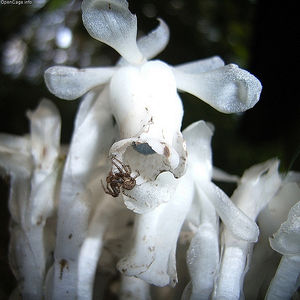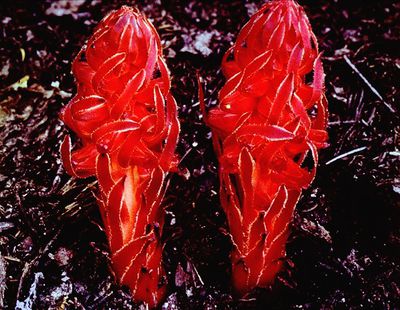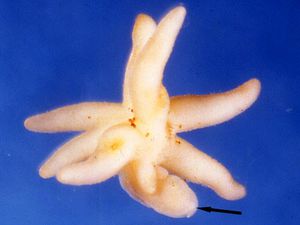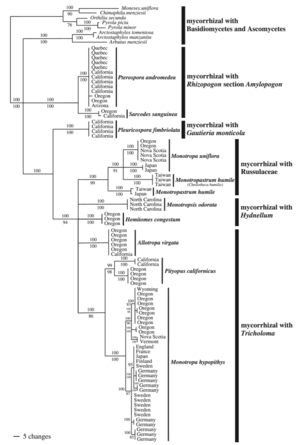Mycoheterotrophy: Difference between revisions
| Line 19: | Line 19: | ||
<br><b>Superscript:</b> Fe<sup>3+</sup> | <br><b>Superscript:</b> Fe<sup>3+</sup> | ||
Mycoheterotrophy is the process by which plants, either wholly or partially [http://en.wiktionary.org/wiki/achlorophyllous achlorophyllous], sustain a [http://en.wikipedia.org/wiki/Heterotroph heterotrophic] metabolism via a fungal partner that provides a source of carbon and mineral nutrients. Mycoheterotrophic plants are considered parasites of their fungal hosts, which are often--but not invariably--associated with the roots of a fully [http://en.wikipedia.org/wiki/Autotroph autotrophic] plant. | |||
Plants are often obligately mycoheterotrophic, with stunted root systems, degenerated vascular tissue, little or no photosynthetic capacity, and "dust-seeds" that contain a fungal inocula but little or no carbon reserves. The mycoheterotrophic plant-fungal relationship is unique inasmuch as in mutualistic [http://en.wikipedia.org/wiki/Mycorrhiza mycorrhizal] associations plants are the carbon source while the fungi provide mineral nutrients (primarily phosphorus and nitrogen). | |||
While the effects of obligate mycoheterotrophs are not usually measured on the ecosystem scale, some evidence exists that adult plants can facilitate the recruitment of proximal conspecific seedlings by supplementing their carbon demand through a common [http://en.wikipedia.org/wiki/Mycelium mycelial] network (i.e., the "wood-wide web"). This process of positive-feedback is thought to be responsible for the establishment of monoculture forest patches dominated by ectomycorrhiza plant species, even within a diverse matrix of surrounding forest. This interaction is considered <i>transitive mycoheterotrophy</i>. | |||
While the effects of obligate mycoheterotrophs are not usually measured on the ecosystem scale, some evidence exists that adult plants can facilitate the recruitment of proximal conspecific seedlings by supplementing their carbon demand through a common mycelial network (i.e., the "wood-wide web"). This process of positive-feedback is thought to be responsible for the establishment of monoculture forest patches dominated by ectomycorrhiza plant species, even within a diverse matrix of surrounding forest. This interaction is considered <i>transitive mycoheterotrophy</i>. | |||
Mycoheterotrophic plants occur in a diverse and unclustered group of plants, which include liverworts, ferns, and monocot (ex. in the order Orchidales) and some dicot (ex. in the family Monotropideae) angiosperms. The fungal hosts include highly specific functional groups of ectomycorrhiza from the orders Basidiomycota and Ascomycota, sometimes called monotropid and orchid mycorrhizas, as well as some arbuscular mycorrhizas from the order Glomeromycota. | Mycoheterotrophic plants occur in a diverse and unclustered group of plants, which include liverworts, ferns, and monocot (ex. in the order Orchidales) and some dicot (ex. in the family Monotropideae) angiosperms. The fungal hosts include highly specific functional groups of ectomycorrhiza from the orders Basidiomycota and Ascomycota, sometimes called monotropid and orchid mycorrhizas, as well as some arbuscular mycorrhizas from the order Glomeromycota. | ||
Revision as of 19:39, 4 April 2011
Introduction
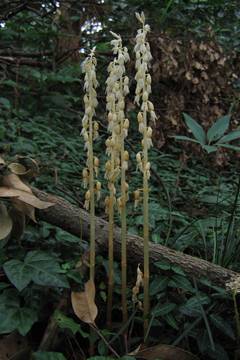
At right is a sample image insertion. It works for any image uploaded anywhere to MicrobeWiki. The insertion code consists of:
Double brackets: [[
Filename: PHIL_1181_lores.jpg
Thumbnail status: |thumb|
Pixel size: |300px|
Placement on page: |right|
Legend/credit: Electron micrograph of the Ebola Zaire virus. This was the first photo ever taken of the virus, on 10/13/1976. By Dr. F.A. Murphy, now at U.C. Davis, then at the CDC.
Closed double brackets: ]]
Other examples:
Bold
Italic
Subscript: H2O
Superscript: Fe3+
Mycoheterotrophy is the process by which plants, either wholly or partially achlorophyllous, sustain a heterotrophic metabolism via a fungal partner that provides a source of carbon and mineral nutrients. Mycoheterotrophic plants are considered parasites of their fungal hosts, which are often--but not invariably--associated with the roots of a fully autotrophic plant.
Plants are often obligately mycoheterotrophic, with stunted root systems, degenerated vascular tissue, little or no photosynthetic capacity, and "dust-seeds" that contain a fungal inocula but little or no carbon reserves. The mycoheterotrophic plant-fungal relationship is unique inasmuch as in mutualistic mycorrhizal associations plants are the carbon source while the fungi provide mineral nutrients (primarily phosphorus and nitrogen).
While the effects of obligate mycoheterotrophs are not usually measured on the ecosystem scale, some evidence exists that adult plants can facilitate the recruitment of proximal conspecific seedlings by supplementing their carbon demand through a common mycelial network (i.e., the "wood-wide web"). This process of positive-feedback is thought to be responsible for the establishment of monoculture forest patches dominated by ectomycorrhiza plant species, even within a diverse matrix of surrounding forest. This interaction is considered transitive mycoheterotrophy.
Mycoheterotrophic plants occur in a diverse and unclustered group of plants, which include liverworts, ferns, and monocot (ex. in the order Orchidales) and some dicot (ex. in the family Monotropideae) angiosperms. The fungal hosts include highly specific functional groups of ectomycorrhiza from the orders Basidiomycota and Ascomycota, sometimes called monotropid and orchid mycorrhizas, as well as some arbuscular mycorrhizas from the order Glomeromycota.
Note that mycoheterotrophy is distinct from the direct plant-plant parasitism that results when plant parasites (ex. mistletoe) develop haustorium that tap directly into a host plant's vascular tissue.
Biological interaction
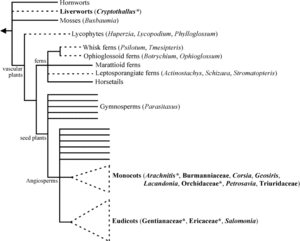
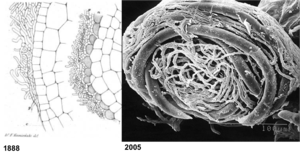
Provide details of the symbiosis or biological interaction. Is this a specific or general interaction? How do these interactions influence the host or other microbial populations, and their activities? How do these interactions influence other organisms (positive or negative influences)? What is the outcome of this interaction? Are there ecological consequences? Describe biological interactions using as many sections/subsections as you require. Look at other topics available in MicrobeWiki. Create links where relevant.
Obligate mycoheterotrophy
Faculative mycoheterotrophy
Niche
Describe the physical, chemical, or spatial characteristics of the niche where we might find this interaction, using as many sections/subsections as you require. Look at other topics available in MicrobeWiki. Create links where relevant.
Subsection 1
Subsection 1a
Subsection 1b
Subsection 2
Microbial processes
What microbial processes define this environment? Describe microbial processes that are important in this habitat, adding sections/subsections as needed. Look at other topics in MicrobeWiki. Are some of these processes already described? Create links where relevant.
Subsection 1
Subsection 1a
Subsection 1b
Subsection 2
Key Microorganisms
What specific kinds of microbes are typically involved in this interaction? Or associated with important processes? Describe key groups (genera, species) of microbes that we find in this environment, and any special adaptations they may have evolved to survive in this environment. List examples of specific microbes that represent key groups or are associated with important processes found in this environment. Add sections/subsections as needed. Look at other microbe listings in MicrobeWiki. Are some of the groups of microbes from your environment already described? Create links to other MicrobeWiki pages where possible.
Subsection 1
Subsection 1a
Subsection 1b
Subsection 2
Microbial processes
What microbial processes are important for this microbial interaction? Does this microbial interaction have some ecosystem-level effects? Does this interaction affect the environment in any way? Describe critical microbial processes or activities that are important in this interaction, adding sections/subsections as needed. Look at other topics in MicrobeWiki. Are some of these processes already described? Create links where relevant.
Current Research
Enter summaries of recent research here--at least three required
References
Edited by <your name>, a student of Angela Kent at the University of Illinois at Urbana-Champaign.
